Synthesis of Novel Pyrazolo[3,4-b]pyridines with Affinity for β-Amyloid Plaques
Abstract
:1. Introduction
2. Results and Discussion
2.1. Synthesis of the Novel Derivatives
2.2. Photochemical Properties
2.3. β-Amyloid Plaque Staining
3. Materials and Methods
3.1. General Remarks
3.2. Synthesis of Compounds
3.2.1. General Procedure for the Preparation of (E)-4-aryl But-3-en-2-ones (8a–c) with Wittig Reaction
3.2.2. General Procedure for the Preparation of 4-Substituted 6-methyl-1-phenyl-1H-pyrazolo[3,4-b]pyridines (5a–c)
3.3. In Vitro Binding to Amyloid Plaques
4. Conclusions
Supplementary Materials
Author Contributions
Funding
Institutional Review Board Statement
Informed Consent Statement
Data Availability Statement
Acknowledgments
Conflicts of Interest
References
- Xing, E.; Zuo, J.; Krogstad, P.; Jung, M.E. Synthesis and Structure−Activity relationship (SAR) studies of novel pyrazolopyridine derivatives as inhibitors of enterovirus replication. J. Med. Chem. 2018, 61, 1688–1703. [Google Scholar] [CrossRef] [PubMed]
- El-Gohary, N.S.; Gabra, M.T.; Shaaban, M.I. Synthesis, molecular modeling and biological evaluation of new pyrazolo[3,4-b]pyridine analogs as potential antimicrobial, antiquorum-sensing and anticancer agents. Bioorg. Chem. 2019, 89, 102976. [Google Scholar] [CrossRef] [PubMed]
- Eagon, S.; Hammill, J.T.; Sigal, M.S.; Ahn, K.J.; Tryhorn, J.E.; Koch, G.; Belanger, B.; Chaplan, C.A.; Loop, L.; Kashtanova, A.S.; et al. Synthesis and structure-activity relationship of dual-stage antimalarial pyrazolo[3,4-b]pyridines. J. Med. Chem. 2020, 63, 11902–11919. [Google Scholar] [CrossRef] [PubMed]
- Ribeiro, J.L.S.; Soares, J.C.A.V.; Portapilla, G.B.; Providello, M.V.; Lima, C.H.S.; Muri, E.M.F.; de Albuquerque, S.; Dias, L.R.S. Trypanocidal activity of new 1,6-diphenyl-1H-pyrazolo[3,4-b]pyridine derivatives: Synthesis, in vitro and in vivo studies. Bioorg. Med. Chem. 2021, 29, 115855. [Google Scholar] [CrossRef]
- Mohamed, L.W.; Shaabana, M.A.; Zahera, A.F.; Alhamaky, S.M.; Elsahar, A.M. Synthesis of new pyrazoles and pyrozolo[3,4-b] pyridines as anti-inflammatory agents by inhibition of COX-2 enzyme. Bioorg. Chem. 2019, 83, 47–54. [Google Scholar] [CrossRef]
- Hu, L.; Li, L.; Chang, Q.; Fu, S.; Qin, J.; Chen, Z.; Li, X.; Liu, Q.; Hu, G.; Li, Q. Discovery of novel pyrazolo[3,4-b] pyridine derivatives with dual activities of vascular remodeling inhibition and vasodilation for the treatment of pulmonary arterial hypertension. J. Med. Chem. 2020, 63, 11215–11234. [Google Scholar] [CrossRef]
- Cappelli, A.; Nannicini, C.; Gallelli, A.; Giuliani, G.; Valenti, S.; la Pericot Mohr, G.; Anzini, M.; Mennuni, L.; Ferrari, F.; Caselli, G.; et al. Design, synthesis, and biological evaluation of AT1 angiotensin II receptor antagonists based on the pyrazolo[3,4-b]pyridine and related heteroaromatic bicyclic systems. J. Med. Chem. 2008, 51, 2137–2146. [Google Scholar] [CrossRef]
- Eissa, I.H.; El-Naggar, A.M.; El-Hashash, M.A. Design, synthesis, molecular modeling and biological evaluation of novel 1H-pyrazolo[3,4-b]pyridine derivatives as potential anticancer agents. Bioorg. Chem. 2016, 67, 43–56. [Google Scholar] [CrossRef]
- Papastathopoulos, A.; Lougiakis, N.; Kostakis, I.K.; Marakos, P.; Pouli, N.; Pratsinis, H.; Kletsas, D. New bioactive 5-arylcarboximidamido pyrazolo[3,4-c]pyridines: Synthesis, cytotoxic activity, mechanistic investigation and structure activity relationships. Eur. J. Med. Chem. 2021, 218, 113387. [Google Scholar] [CrossRef]
- Michailidou, M.; Giannouli, V.; Kotsikoris, V.; Papadodima, O.; Kontogianni, G.; Kostakis, I.K.; Lougiakis, N.; Chatziioannou, A.; Kolisis, F.N.; Marakos, P.; et al. Novel pyrazolopyridine derivatives as potential angiogenesis inhibitors: Synthesis, biological evaluation and transcriptome-based mechanistic analysis. Eur. J. Med. Chem. 2016, 121, 143–157. [Google Scholar] [CrossRef]
- Uno, T.; Kawai, Y.; Yamashita, S.; Oshiumi, H.; Yoshimura, C.; Mizutani, T.; Suzuki, T.; Chong, K.T.; Shigeno, K.; Ohkubo, M.; et al. Discovery of 3-Ethyl-4-(3- isopropyl-4-(4-(1-methyl-1H-pyrazol-4-yl)-1H-imidazole-1-yl)-1H-pyrazolo[3,4-b]pyridin-1-yl) benzamide (TAS-116) as a potent, selective, and orally available HSP90 inhibitor. J. Med. Chem. 2019, 62, 531–551. [Google Scholar] [CrossRef] [PubMed]
- Hao, S.-Y.; Qi, Z.-Y.; Wang, S.; Wang, X.-R.; Chen, S.-W. Synthesis and bioevaluation of N-(3,4,5-trimethoxyphenyl)-1H-pyrazolo[3,4-b]pyridin-3- amines as tubulin polymerization inhibitors with anti-angiogenic effects. Bioorg. Med. Chem. 2021, 31, 115985. [Google Scholar] [CrossRef] [PubMed]
- Zhai, M.; Liu, S.; Gao, M.; Wang, L.; Sun, J.; Du, J.; Guan, Q.; Bao, K.; Zuo, D.; Wu, Y.; et al. 3,5-Diaryl-1H-pyrazolo[3,4-b]pyridines as potent tubulin polymerization inhibitors: Rational design, synthesis and biological evaluation. Eur. J. Med. Chem. 2019, 168, 426–435. [Google Scholar] [CrossRef] [PubMed]
- Wenglowsky, S. Pyrazolo[3,4-b]pyridine kinase inhibitors: A patent review (2008—present). Expert Opin. Ther. Pat. 2013, 23, 3. [Google Scholar] [CrossRef]
- Ankur, J.; Mahesh, R.; Bhatt, S. Anxiolytic-like effect of etazolate, a type 4 phosphodiesterase inhibitor in experimental models of anxiety. Indian. J. Exp. Biol. 2013, 51, 444–449. [Google Scholar]
- Siopi, E.; Llufriu-Daben, G.; Cho, A.H.; Vidal-Lletjos, S.; Plotkine, M.; Marchand-Leroux, C.; Jafarian-Tehrani, M. Etazolate, an alpha-secretase activator, reduces neuroinflammation and offers persistent neuroprotection following traumatic brain injury in mice. Neuropharmacology 2013, 67, 183–192. [Google Scholar] [CrossRef]
- Marcade, M.; Bourdin, J.; Loiseau, N.; Peillon, H.; Rayer, A.; Drouin, D.; Schweighoffer, F.; Desire, L. Etazolate, a neuroprotective drug linking GABA(A) receptor pharmacology to amyloid precursor protein processing. J. Neurochem. 2008, 106, 392–404. [Google Scholar] [CrossRef]
- Vellas, B.; Sol, O.; Snyder, P.J.; Ousset, P.-J.; Haddad, R.; Maurin, M.; Lemarie, J.-C.; Desire, L.; Pando, M.P. EHT0202 in Alzheimer’s disease: A 3-month, randomized, placebo-controlled, double-blind study. Curr. Alzheimer Res. 2011, 8, 203–212. [Google Scholar] [CrossRef]
- Lynch, C. World Alzheimer Report 2019: Attitudes to dementia, a global survey. Alzheimer’s Dement. 2020, 16, e038255. [Google Scholar] [CrossRef]
- Wisniewski, T.; Drummond, E. Future horizons in Alzheimer’s disease research. Prog. Mol. Biol. Transl. Sci. 2019, 168, 223–241. [Google Scholar] [CrossRef]
- Tiwari, S.; Atluri, V.; Kaushik, A.; Yndart, A.; Nair, M. Alzheimer’s disease: Pathogenesis, diagnostics, and therapeutics. Int. J. Nanomed. 2019, 14, 5541–5554. [Google Scholar] [CrossRef] [Green Version]
- Cras, P.; Kawai, M.; Lowery, D.; Gonzalez-DeWhitt, P.; Greenberg, B.; Perry, G. Senile plaque neurites in Alzheimer disease accumulate amyloid precursor protein. Proc. Natl. Acad. Sci. USA 1991, 88, 7552–7556. [Google Scholar] [CrossRef] [PubMed] [Green Version]
- Grundman, M.; Pontecorvo, M.J.; Salloway, S.P.; Doraiswamy, P.M.; Fleisher, A.S.; Sadowsky, C.H.; Nair, A.K.; Siderowf, A.; Lu, M.; Arora, A.K.; et al. Potential impact of amyloid imaging on diagnosis and intended management in patients with progressive cognitive decline. Alzheimer Dis. Assoc. Disord. 2013, 27, 4–15. [Google Scholar] [CrossRef] [PubMed]
- Zwan, M.D.; Bouwman, F.H.; Konijnenberg, E.; van der Flier, W.M.; Lammertsma, A.A.; Verhey, F.R.J.; Aalten, P.; van Berckel, B.N.M.; Scheltens, P. Diagnostic impact of [18F] flutemetamol PET in early-onset dementia. Alzheimer’s Res. Ther. 2017, 9, 2. [Google Scholar] [CrossRef] [PubMed] [Green Version]
- Boccardi, M.; Altomare, D.; Ferrari, C.; Festari, C.; Guerra, U.P.; Paghera, B.; Pizzocaro, C.; Lussignoli, G.; Geroldi, C.; Zanetti, O.; et al. Assessment of the Incremental Diagnostic Value of Florbetapir F 18 Imaging in Patients With Cognitive Impairment. JAMA Neurol. 2016, 73, 1417–1424. [Google Scholar] [CrossRef] [Green Version]
- Ishii, K.; Ishibashi, K.; Sakata, M.; Wagatsuma, K.; Toyohara, J.; Murayama, S. P4-332: Clinical Impact of Amyloid PET with [C-11] Pittsburgh Compound b on the Diagnosis of Early Onset Dementias. Alzheimer’s Dement. 2016, 12, 1161–1162. [Google Scholar] [CrossRef]
- Klunk, W.E.; Engler, H.; Nordberg, A.; Wang, Y.; Blomqvist, G.; Holt, D.P.; Bergström, M.; Savitcheva, I.; Huang, G.F.; Estrada, S.; et al. Imaging brain amyloid in Alzheimer’s disease with Pittsburgh Compound-B. Ann. Neurol. 2004, 55, 306–319. [Google Scholar] [CrossRef]
- Yamin, G.; Teplow, D.B. Pittsburgh Compound-B (PiB) binds amyloid β-protein protofibrils. J. Neurochem. 2017, 140, 210–215. [Google Scholar] [CrossRef] [Green Version]
- van Waarde, S.A.; Marcolini, P.P.; de Deyn, R.; Dierckx, R.A.J.O. PET agents in dementia: An overview. Semin. Nucl. Med. 2021, 51, 196–229. [Google Scholar] [CrossRef]
- Chandra, A.; Valkimadi, P.E.; Pagano, G.; Cousins, O.; Dervenoulas, G.; Politis, M. Applications of amyloid, tau, and neuroinflammation PET imaging to Alzheimer’s disease and mild cognitive impairment. Hum. Brain. Mapp. 2019, 40, 5424–5442. [Google Scholar] [CrossRef] [Green Version]
- Elmaleh, D.R.; Farlow, M.R.; Conti, P.S.; Tompkins, R.G.; Kundakovic, L.; Tanzi, R.E. Developing Effective Alzheimer’s Disease Therapies: Clinical Experience and Future Directions. J. Alzheimer’s Dis. 2019, 71, 715–732. [Google Scholar] [CrossRef] [PubMed] [Green Version]
- Sagnou, M.; Mavroidi, B.; Shegani, A.; Paravatou-Petsotas, M.; Raptopoulou, C.; Psycharis, V.; Pirmettis, I.; Papadopoulos, M.S.; Pelecanou, M. Remarkable Brain Penetration of Cyclopentadienyl M(CO)3+ (M = 99mTc, Re) Derivatives of Benzothiazole and Benzimidazole Paves the Way for Their Application as Diagnostic, with Single-Photon-Emission Computed Tomography (SPECT), and Therapeutic Agents for Alzheimer’s Disease. J. Med. Chem. 2019, 62, 2638–2650. [Google Scholar] [CrossRef] [PubMed]
- Triantis, C.; Tsotakos, T.; Tsoukalas, C.; Sagnou, M.; Raptopoulou, C.; Terzis, A.; Psycharis, V.; Pelecanou, M.; Pirmettis, I.; Papadopoulos, M. Synthesis and characterization of fac-[M(CO)3(P)(OO)] and cis-trans-[M(CO)2(P)2(OO)] complexes (M = Re, 99mTc) with acetylacetone and curcumin as OO donor bidentate ligands. Inorg. Chem. 2013, 52, 12995–13003. [Google Scholar] [CrossRef] [PubMed]
- Sagnou, M.; Tzanopoulou, S.; Raptopoulou, C.P.; Psycharis, V.; Braband, H.; Alberto, R.; Pirmettis, I.C.; Papadopoulos, M.; Pelecanou, M. A phenylbenzothiazole conjugate with the tricarbonyl fac-M(I)(CO)3+ (M = Re, 99Tc, 99mTc) core for imaging of β-amyloid plaques. Eur. J. Inorg. Chem. 2012, 27, 4279–4286. [Google Scholar] [CrossRef]
- Sagnou, M.; Benaki, D.; Triantis, C.; Tsotakos, T.; Psycharis, V.; Raptopoulou, C.P.; Pirmettis, I.; Papadopoulos, M.; Pelecanou, M. Curcumin as the OO Bidentate Ligand in “2 + 1” Complexes with the [M(CO)3] (M = Re, 99mTc) Tricarbonyl Core for Radiodiagnostic Applications. Inorg. Chem. 2011, 50, 1295–1303. [Google Scholar] [CrossRef]
- Orrego-Hernández, J.; Lizarazo, C.; Cobo, J.; Portilla, J. Pyrazolo-fused 4-azafluorenones as key reagents for the synthesis of fluorescent dicyanovinylidene-substituted derivatives. RSC Adv. 2019, 9, 27318–27323. [Google Scholar] [CrossRef] [Green Version]
- Chen, J.; Liu, W.; Ma, J.; Xu, H.; Wu, J.; Tang, X.; Fan, Z.; Wang, P. Synthesis and Properties of Fluorescence Dyes: Tetracyclic Pyrazolo[3,4-b]Pyridine-Based Coumarin Chromophores with Intramolecular Charge Transfer Character. J. Org. Chem. 2012, 77, 3475–3482. [Google Scholar] [CrossRef]
- Wube, A.A.; Hüfner, A.; Thomaschitz, C.; Blunder, M.; Kollroser, M.; Bauer, R.; Bucar, F. Design, synthesis and antimycobacterial activities of 1-methyl-2-alkenyl-4(1H)-quinolones. Bioorg. Med. Chem. 2011, 19, 567–579. [Google Scholar] [CrossRef] [Green Version]
- Silva, T.B.; Bernardino, A.M.; Maria de Lourdes, G.F.; Rogerio, K.R.; Carvalho, L.J.; Boechat, N.; Pinheiro, L.C. Design, synthesis and anti-P. falciparum activity of pyrazolopyridine—sulfonamide derivatives. Bioorg. Med. Chem. 2016, 24, 4492–4498. [Google Scholar] [CrossRef]
- El-Enany, M.M.; El-Meligie, S.E.; Abdou, N.A.; El-Nassan, H.B. Synthesis of pyrazolo[3,4-b]pyridine and pyrido[2′,3′:3,4]pyrazolo[1,5-a]pyrimidine derivatives. J. Chem. Res. 2010, 34, 470–474. [Google Scholar] [CrossRef]
- Liu, M.; Yin, G. ZrCl4-catalysed synthesis of new 4-(2-hydroxyphenyl)pyrazolo[3,4-b]pyridine derivatives. J. Chem. Res. 2015, 39, 263–266. [Google Scholar] [CrossRef]
- Kolos, N.N.; Kovalenko, L.U.; Borovskoy, V.A. Reactions of 3-acryloates with α-aminoazoles. Chem. Heterocycl. Comp. 2011, 47, 983–988. [Google Scholar] [CrossRef]
- Shi, D.-Q.; Zhou, Y.; Liu, H. An Efficient Synthesis of Pyrazolo[3,4-b]pyridine Derivatives in Ionic Liquid. Synth. Commun. 2010, 40, 3660–3668. [Google Scholar] [CrossRef]
- Orlov, V.D.; Kiroga, K.; Kolos, N.N. Synthesis of aromatic pyrazolo[4,5-b]pyridine derivatives. Chem. Heterocycl. Compd. 1987, 23, 997–1000. [Google Scholar] [CrossRef]
- Joshi, K.C.; Pathak, V.N.; Sareen, V.; Garg, U. Synthesis of some new fluorine-containing 5-amino-1,3-disubstituted pyrazoles and 1H-pyrazolo[3,4-b]pyridines. J. Heterocycl. Chem. 1979, 16, 1141–1145. [Google Scholar] [CrossRef]
- Mohan, M.; James, J.; Satyanarayan, M.N.; Trivedi, D.R. Functionalized pyrene-based AIEgens: Synthesis, photophysical characterization and density functional theory studies. Luminescence 2019, 34, 715–723. [Google Scholar] [CrossRef] [PubMed]
- Becker, H.D.; Andersson, K. On the relationship between molecular geometry and excited-state properties of 9-anthrylalkenes. J. Org. Chem. 1983, 48, 4542–4549. [Google Scholar] [CrossRef]
- Santoro, A.; Tuyèras, F.; Dupeyre, G.; Laine, P.P.; Ciofini, I.; Nastasi, F.; Fausto, P.; Campagna, S. Pyrimidyl-substituted anthracene fluorophores: Syntheses, absorption spectra, and photophysical properties. Dyes Pigment. 2018, 159, 619–636. [Google Scholar] [CrossRef]
- Jia, J.; Zhang, L.; Song, J.; Dai, J.; Cui, M. Discovery of Diphenoxy Derivatives with Flexible Linkers as Ligands for β-Amyloid Plaques. Mol. Pharm. 2020, 17, 4089–4100. [Google Scholar] [CrossRef]
- Kim, S.; Kumari, N.; Lim, J.; Dubbu, S.; Kumar, A.; Lee, I.S. Silica Jar-with-Lid as Chemo-Enzymatic Nano-Compartment for Enantioselective Synthesis inside Living Cells. Angew. Chem. Int. Ed. Engl. 2021, 60, 16337–16342. [Google Scholar] [CrossRef]
- Mase, N.; Takabe, K.; Tanaka, F. Erratum to “Fluorogenic probes for chemical transformations: 9-anthracene derivatives for monitoring reaction progress by an increase in fluorescence”. Tetrahedron Lett. 2013, 54, 5140. [Google Scholar] [CrossRef]
- Magoulas, G.E.; Bariamis, S.E.; Athanassopoulos, C.M.; Haskopoulos, A.; Dedes, P.G.; Krokidis, G.M.; Karamanos, K.N.; Kletsas, D.; Papaioannou, D.; Maroulis, G. Syntheses, antiproliferative activity and theoretical characterization of acitretin-type retinoids with changes in the lipophilic part. Eur. J. Med. Chem. 2011, 46, 721–737. [Google Scholar] [CrossRef] [PubMed]
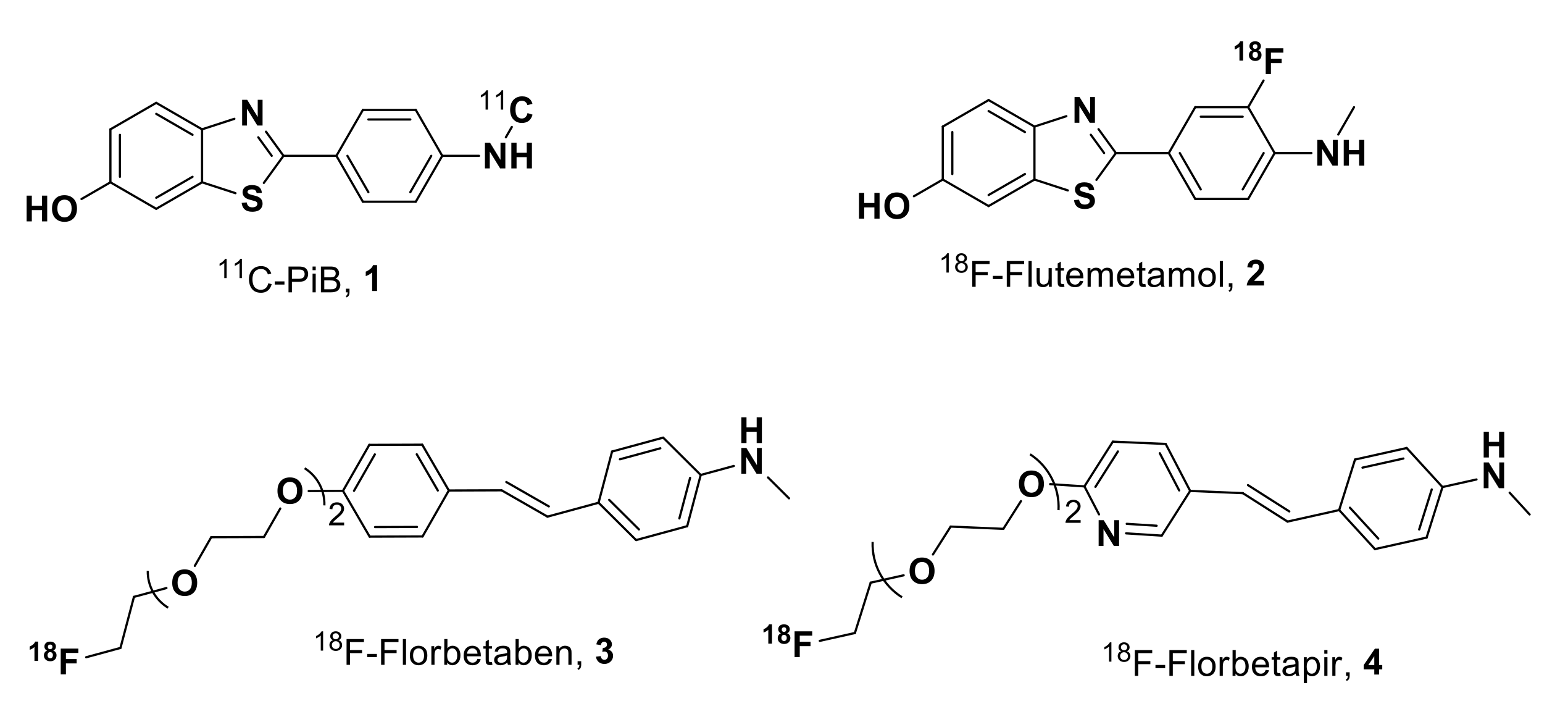

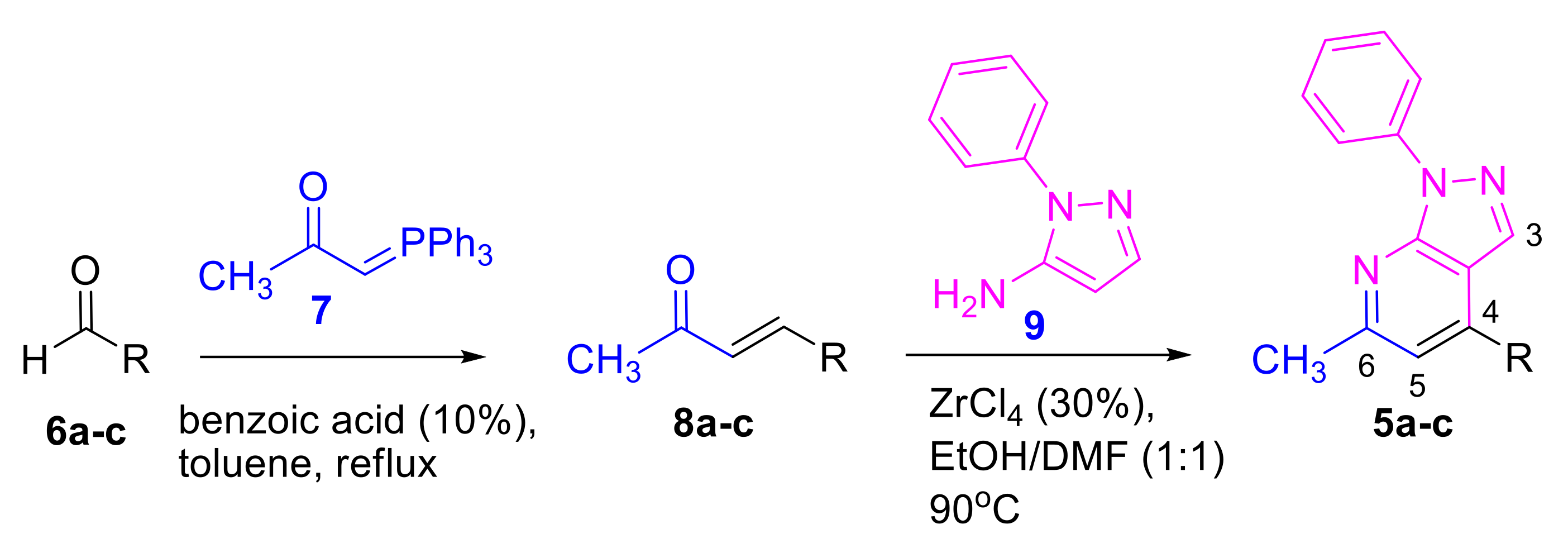
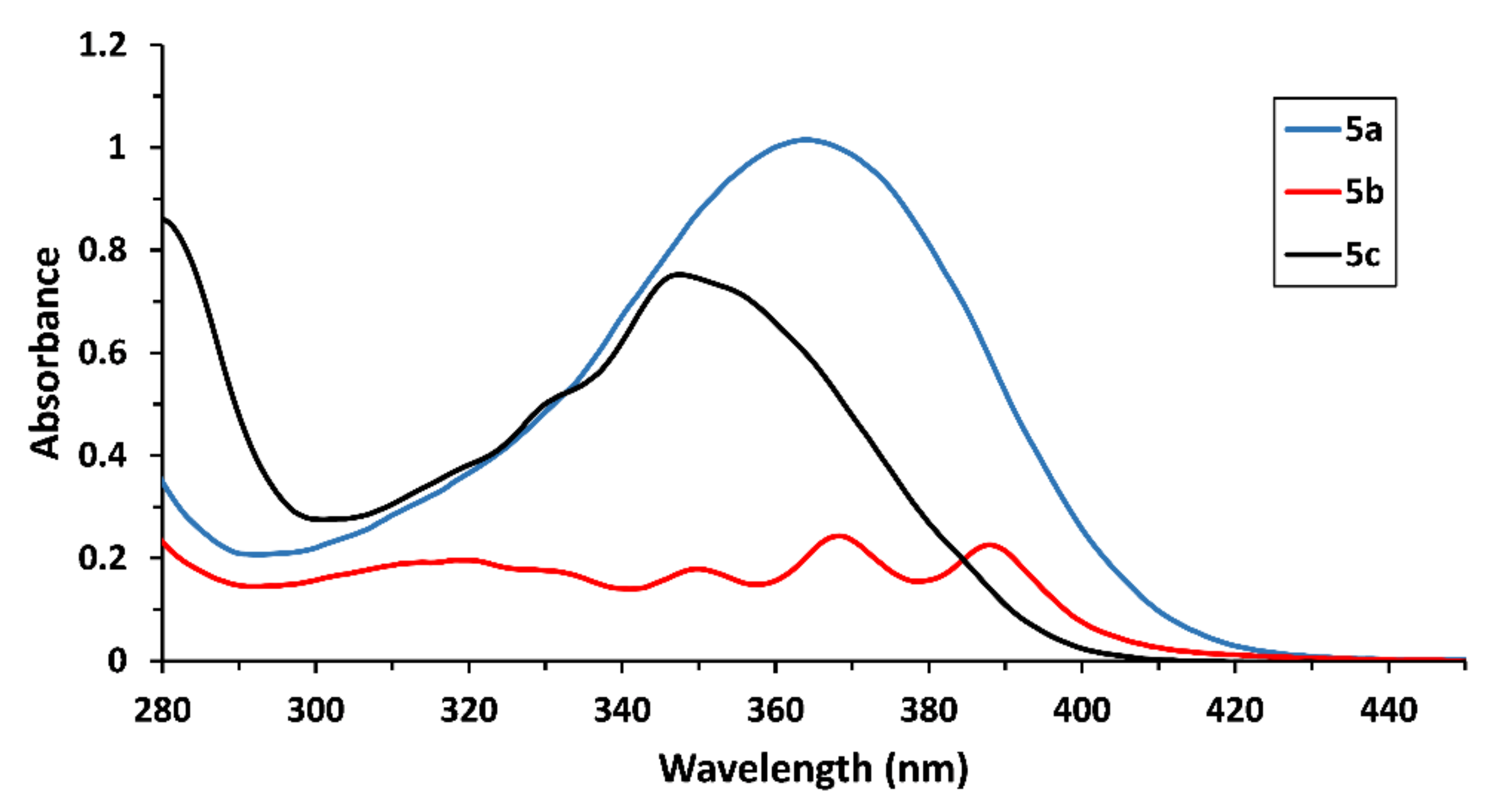
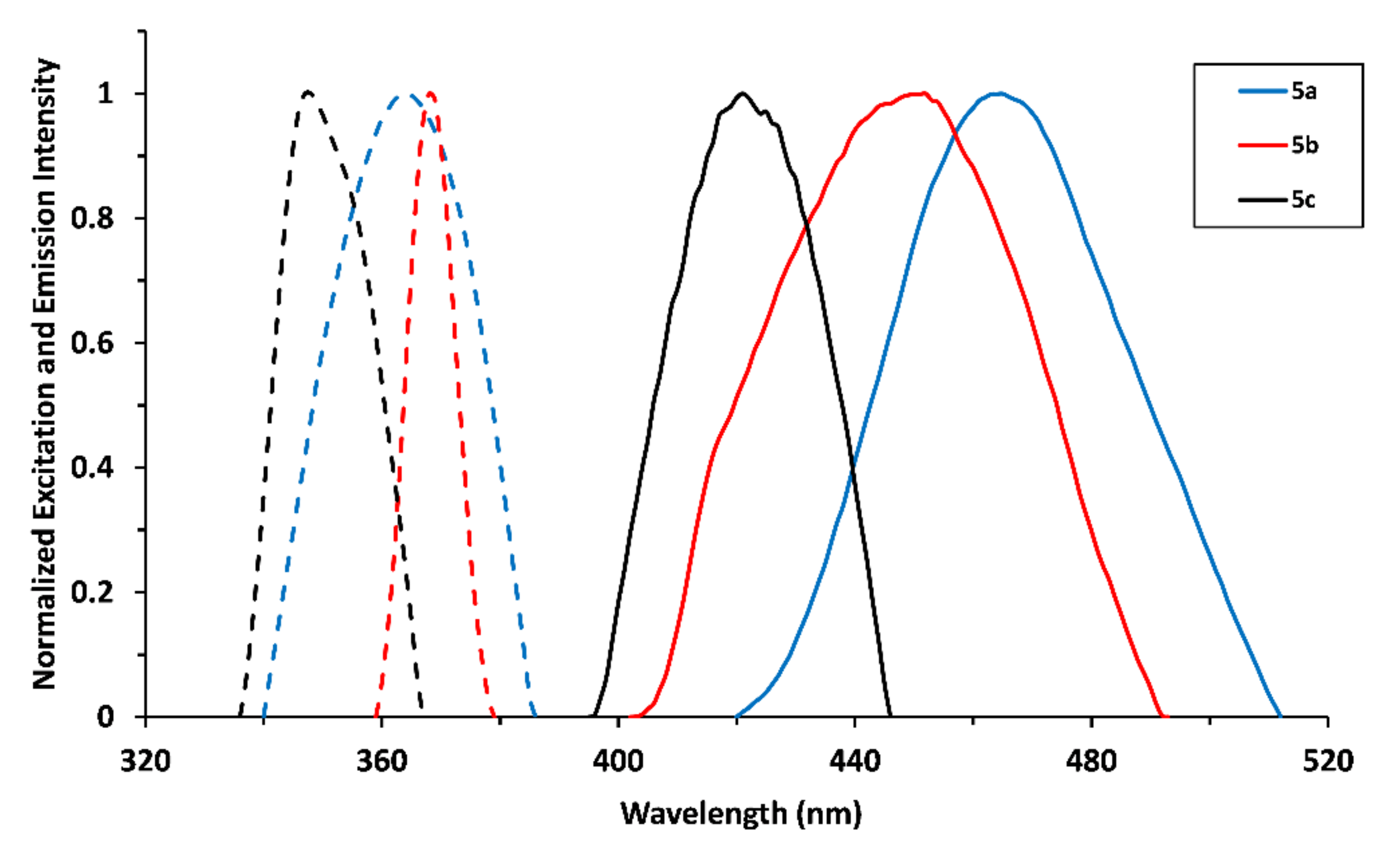
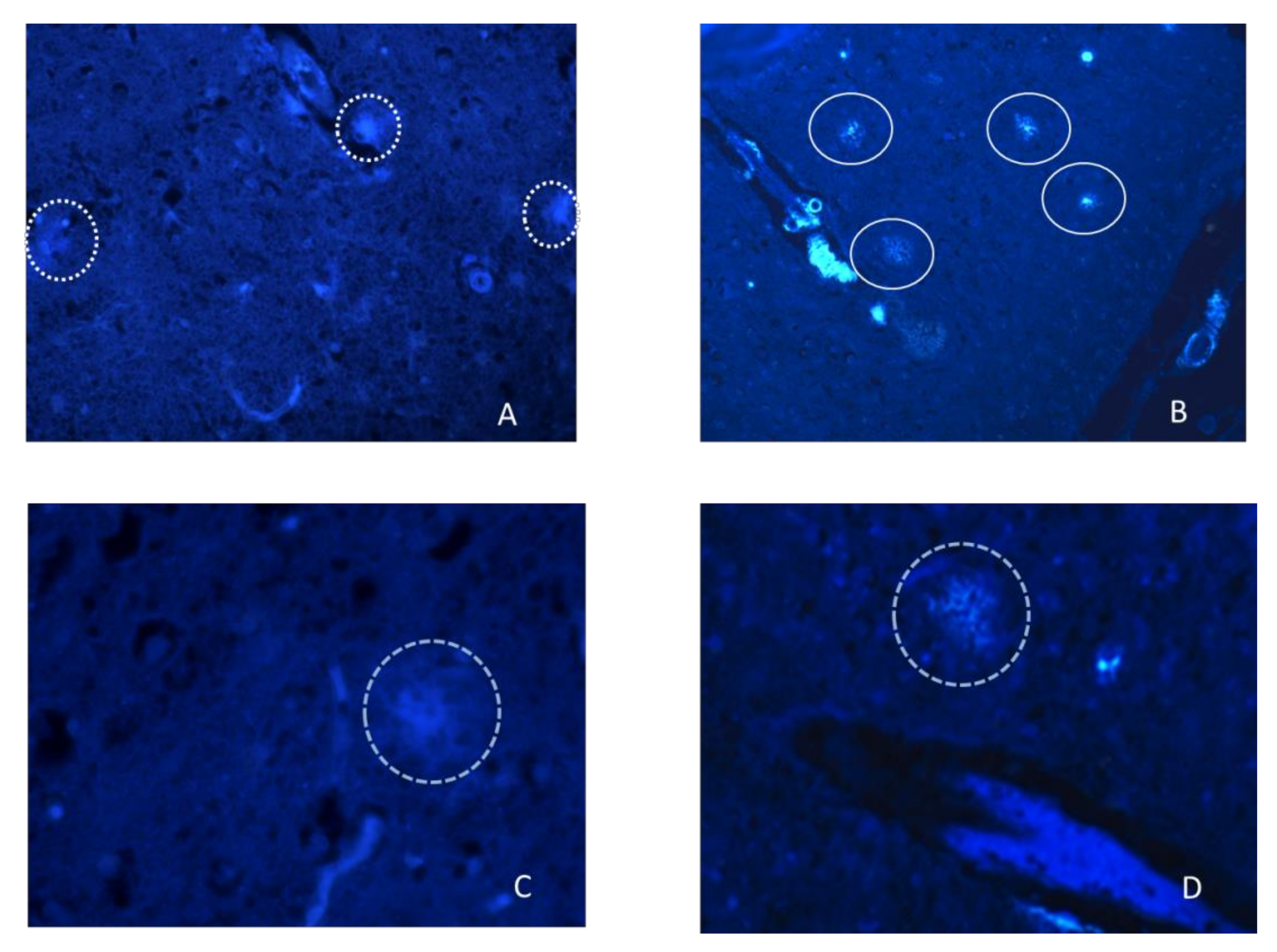
| Compound | λabs (nm) | λem (nm) | Δλ (nm) |
|---|---|---|---|
| 5a | 364 | 465 | 101 |
| 5b | 368 | 452 | 84 |
| 5c | 348 | 421 | 73 |
Publisher’s Note: MDPI stays neutral with regard to jurisdictional claims in published maps and institutional affiliations. |
© 2022 by the authors. Licensee MDPI, Basel, Switzerland. This article is an open access article distributed under the terms and conditions of the Creative Commons Attribution (CC BY) license (https://creativecommons.org/licenses/by/4.0/).
Share and Cite
Vidali, V.P.; Nigianni, G.; Athanassopoulou, G.D.; Canko, A.; Mavroidi, B.; Matiadis, D.; Pelecanou, M.; Sagnou, M. Synthesis of Novel Pyrazolo[3,4-b]pyridines with Affinity for β-Amyloid Plaques. Molbank 2022, 2022, M1343. https://doi.org/10.3390/M1343
Vidali VP, Nigianni G, Athanassopoulou GD, Canko A, Mavroidi B, Matiadis D, Pelecanou M, Sagnou M. Synthesis of Novel Pyrazolo[3,4-b]pyridines with Affinity for β-Amyloid Plaques. Molbank. 2022; 2022(1):M1343. https://doi.org/10.3390/M1343
Chicago/Turabian StyleVidali, Veroniki P., Georgia Nigianni, Georgia D. Athanassopoulou, Aleksander Canko, Barbara Mavroidi, Dimitris Matiadis, Maria Pelecanou, and Marina Sagnou. 2022. "Synthesis of Novel Pyrazolo[3,4-b]pyridines with Affinity for β-Amyloid Plaques" Molbank 2022, no. 1: M1343. https://doi.org/10.3390/M1343
APA StyleVidali, V. P., Nigianni, G., Athanassopoulou, G. D., Canko, A., Mavroidi, B., Matiadis, D., Pelecanou, M., & Sagnou, M. (2022). Synthesis of Novel Pyrazolo[3,4-b]pyridines with Affinity for β-Amyloid Plaques. Molbank, 2022(1), M1343. https://doi.org/10.3390/M1343








